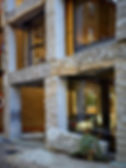Rock follies
- Chris Rogers
- May 3
- 4 min read
Anyone seeking to spy a wild dolphin from Scarborough’s recently-opened seafront viewing station this weekend might, as they hurry toward the free telescopes, walk over what appear to be fragments of an ancient Roman mosaic. Fortunately this isn’t council crassness, but a new site-specific artwork by Jeremy Deller and Coralie Turpin that nods towards the town’s actual history whilst having some fun. It’s the latest manifestation of an English eccentricity dating back centuries that has yielded fake mediaeval buildings, Classical caryatids with Hollywood hairstyles and the startling remnants of a fictional museum.

Deller and Turpin‘s Roman Mosaic c.2025 enjoys itself, depicting subjects that might well be found in an actual Roman villa’s floor mosaic as well as some that one that certainly wouldn’t, as Hannah Clugston points out. Architectural decoration like this is usually on a small scale, yet this trend of playing make believe with stone has some building-sized precedents.
Follies were erected in the grounds of many great estates in the 18th century. Some had a practical function, as hunting lodges, belvederes or summerhouses, whilst some merely disguised chimneys, water outlets and other items of necessary but unattractive infrastructure. Many, though, were erected simply for delight, to balance or terminate a view or provide a conversation piece. Within that sub-category sits the sham ruin.
Whilst the landed gentry had pedigree and little need to shout about it, the elaborate homes they built were felt to benefit from the architectural equivalent, an implied continuity of prestige and power in built form. Thus where a house from an earlier era had finally to be abandoned in favour of its replacement, elements of the former were sometimes retained as a talking point. The abandoned walls of dissolved monasteries, where present, provided something similar. Some lords were fortunate to have a much older structure on their land; in Hertfordshire the Palladian house of Gorhambury by Sir Robert Taylor overlooks the remains of a Roman open-air theatre. Those without such a treasure could however construct one.

At Hagley Hall in Worcestershire the owner’s new Neoclassical house came with its own fake Gothic ruin, a tower with attached walls that was built nearby at the same time. Mowbray Castle in North Yorkshire is neither a castle nor ‘real’, having been carefully placed within William Aislabie’s new landscaped gardens to provide a romantic view, one later painted by Turner. Even London was not immune. When Sir John Soane, the great architect and antiquarian, built his country house in Ealing, he included mock Roman remains in its grounds which he would explain to visitors as being evidence of a genuine temple.
This knowing deployment of the past for the needs of the present didn’t stop in the 20th century. Victorian architect John Belcher had designed the Chartered Accountants' Hall in the City of London in Baroque style. In 1931 it was extended by John James Joass, who copied his late partner’s façade exactly save for the first floor caryatids, who sport Louise Brooks bobs instead of ancient Greek coiffures (forty years later the Modernist William Whitfield maintained this playfulness by emulating that same Baroque approach along the remainder of the road before swinging round the corner and allowing stone columns to give way to reeded concrete, friezes to polished granite and small-paned window bays to expansive frosted glazing).

Whitfield was also designing several buildings for the University of Glasgow during this period. Here he used Brutalism undisguised, for a confident, forward-facing campus, yet his Hunterian Museum and Art Gallery Extension also contained a call back to a very specific past. The complex was built on a cleared site on which had stood terraced housing, including the former home of Charles Rennie Mackintosh and his wife Margaret McDonald. Its delicate, Art Nouveau interiors were saved and faithfully recreated inside the new building but Whitfield reflected this on the outside by moulding the latter’s cast concrete exterior to mimic the Mackintosh house’s massing, including its bay windows, fenestration and door – though all are perched several feet above ground level and the Hunterian’s perimeter glacis, this last a feature typical of Brutalim.

One of its successor movements, Post-Modernism, gave rise to an entire canon of projects where games were played with motifs plucked from earlier eras and probably deserves a post of its own. But for now, the sheer bravura of designer and developer Ian Pollard’s Kensington branch of the Homebase DIY chain must take the biscuit. A consequence of then owner J. Sainsbury’s programme of asking private architects to create certain stores in an effort to raise their perceived urban quality, the result was – to put it mildly – not what might reasonably have been expected when unveiled in 1988. Striped walls of granite facing the car park suddenly gave way to planes of smooth plaster incised with giant representations of Egyptian gods bearing ankhs (and power drills), whilst customers pulled up behind a screen of columns with polychrome capitals and entered under a portico with cavetto cornice. Wilfully absurd as an enterprise, the columns were later whitewashed and a Corinthian entablature removed after, it is rumoured, one of the Sainsbury brothers themselves personally took offence at such, er, folly. The building was demolished a decade ago, no doubt causing future archaeologists some confusion.

Yet in the 21st century we still find the joke extended in the telling. Amin Taha constructed 15 Clerkenwell Close, a multi-storey, mixed-use block, from structural limestone, treating each piece differently in reference to past ways of building and incorporating near the entrance a supposedly ‘fallen’ column that itself is left partly carved and party unfinished. And returning to architectural decoration and sculpture, Damien Hirst’s installation Treasures from the Wreck of the Unbelievable seen in Venice a few years ago gave us something that was as connected to the sea as Jeremy Deller’s Scarborough piece but on a somewhat larger scale.
Purporting to be a trove of (often titanic) statues, artworks and treasure from ancient times raised from a sunken ship, the collection was a dazzling, truly fantastical melange that merged myths from a dozen realities with pure fiction. Making them from – or at least simulating – a wide range of materials, Hirst gifted each item with a history and a provenance and crafted a detailed narrative for the entire enterprise. Siting the whole within the palazzos of a once-great maritime power whose impressive reach encompassed Gallipoli and Crete simply added to the illusion.
So whilst architecture and its allied arts is always serious, it doesn’t always have to be sober.